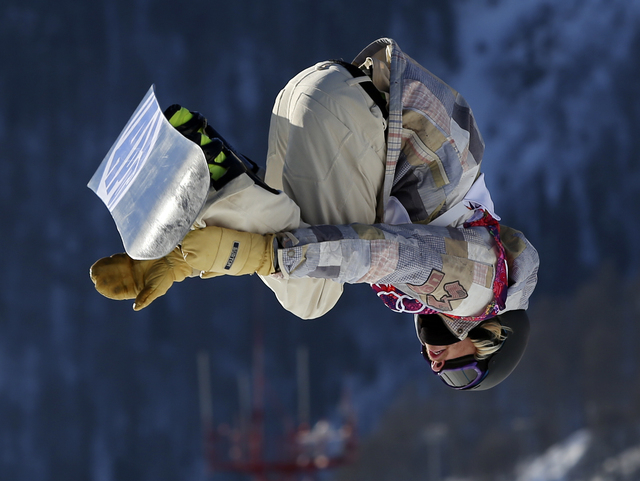USA’s Kotsenburg wins first gold with new trick

KRASNAYA POLYANA, Russia — Sage Kotsenburg loves snowboarding for all its unexpected surprises.
Winning the first Olympic gold medal in slopestyle, for one.
And winning it with one trick he’d never tried before and another that included a self-invented grab of the board he named the “Holy Crail.”
The 20-year-old American jetted off the first big jump of the slopestyle course Saturday and whirled around for 3 1/2 rotations while flipping twice. All the while, he was grabbing the front of his board with one hand and the nose of the board with the other.
At the bottom, he helicoptered through 4 1/2 rotations, while grabbing his board and flexing it behind his back.
“Never even tried it before,” Kotsenburg said. “Never, ever tried it in my life.”
Kotsenburg landed both jumps cleanly. The fans in the mostly full stands, knowing they had seen something completely different in a completely new Olympic sport, let out a huge gasp after the second one.
On the strength of those tricks — the Cab Double Cork 1260 with a Holy Crail grab and a Back 1620 Japan Air — the kid from Coeur d’Alene, Idaho, known as “Second Run Sage,” posted a winning score of 93.5 on his first run.
Nobody in the 12-man field of finalists could top him. Kotsenburg put the first gold medal of the Sochi Games into the “USA” column. Soon after, he and the other medalists, Staale Sandbech of Norway and Mark McMorris of Canada, were hugging, body-slamming and turning their sport’s “Kiss and Cry” zone into a mosh pit.
“I kind of do random stuff all the time, never make a plan up,” Kotsenburg said. “I had no idea I was even going to do a 1620 in my run until three minutes before I dropped. It’s kind of what I’m all about.”
Kotsenburg’s jumps were the high point of yet another sunny, windless day at the Rosa Khutor Extreme Park. Combining all that, along with a bit of half-expected, half-legitimate griping about the judging, made it easy to forget that Shaun White had pulled out of this event before qualifying, complaining about the toughness of the course.
White, one of the most cutting-edge innovators in the game, was practicing on the halfpipe below when Kotsenburg landed the 1620 Japan Air.
Despite the excitement of that trick, there was some head-scratching going on elsewhere.
Sandbech, McMorris and Winter X Games champion Max Parrot were among those who threw the much-ballyhooed triple cork, which is three head-over-heels flips — considered way more dangerous and athletic and presumed to be the must-have trick to win the first Olympic gold in this sport’s history.
Kotsenburg never tried one.
There are, of course, seven or eight tricks in every run — boxes to jump on, rails to ride over and even the option to jump over the giant Russian nesting doll near the top of the course. Splashes and bobbles on any of them can cost precious points.
But rider after rider came off the course and concluded that Kotsenburg’s win symbolized a shift in the sport; that judges are looking for more technical moves with so-called style rather than a simple gymnastics meet on the snow.
“I think definitely Mark and Staale did some runs that should’ve scored higher. Sage had some really creative stuff. But whatever,” said Canada’s Sebastien Toutant, who finished ninth. “They’re all homeys. They deserved it. The sport is getting judged by humans and life goes on.”
Sandbech celebrated his clean triple cork at the bottom by swan diving into the snow.
The crowd loved it. The judges only gave it a 91.75.
“It was kind of hard from the start to know what the judges were awarding for,” he said.
As recently as a month ago, McMorris was considered a favorite to win the gold, whether White showed up at the contest or not.
But he broke a rib after slamming into a rail during the finals of the Winter X Games two weeks ago. There was some thought he’d wear a Kevlar vest to protect himself, but no.
He thought his run might get a higher mark than the 88.75 he received. Didn’t happen.
Then, he was sure he’d been knocked off the podium when Parrot, also from Canada, went last and also landed the triple. Parrot finished fifth.
“If you ride the best you can ride, and you’re satisfied with that, the rest is up to the judges,” McMorris said. “To be honest, that’s the least of my worries. I’m just really, really thankful, from where I was two weeks ago, to be on the podium.”
Kotsenburg is, too.
When he was a kid, he went to snowboarding camp in Oregon and Mike Jankowski, the coach there and now the coach of the U.S. team, tried to coax kids away from the big features and over to the halfpipe, where the fundamentals are taught.
Wasn’t so easy with this kid. He always wanted to do the jumps.
“For Sage, that’s what he’s about,” Jankowski said. “It’s keeping snowboarding fun, whether the judges like his run, whether he gets a high score or a low score.”